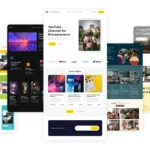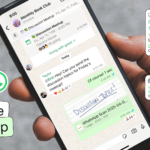Click here to buy secure, speedy, and reliable Web hosting, Cloud hosting, Agency hosting, VPS hosting, Website builder, Business email, Reach email marketing at 20% discount from our Gold Partner Hostinger You can also read 12 Top Reasons to Choose Hostinger’s Best Web Hosting
Are you among the millions who believe Gmail’s latest security updates have your back? Security researchers warn that Gmail encryption phishing risk is soaring when misused by cybercriminals. In late April 2025, Google began rolling out a beta end-to-end encryption option for Workspace customers—aimed at making encrypted email as easy as a single click. While this seems like a win for privacy, the invitation mechanism that allows non-Gmail users to view encrypted messages can be mimicked by scammers looking to steal credentials. In this post, you’ll learn how the feature works, why it introduces new phishing vectors, and which immediate steps you and your organization can take to stay protected.
3 VPNs That Pass All Tests (2025)
NordVPN: Zero leaks in tests, RAM-only servers, and Threat Protection to block malware.
Surfshark: Unlimited devices, Camouflage Mode for bypassing VPN blocks, and CleanWeb ad-blocker.
ExpressVPN: Trusted Server tech (data wiped on reboot) and consistent streaming access.
Gmail Encryption Phishing Risk Feature Exposes Millions
Google’s end-to-end encryption beta is designed to let Workspace admins enable encryption for all outbound messages—without requiring recipients to install additional software. Yet by managing encryption keys in the Workspace Admin console (rather than on individual devices), the system stops short of true, device-only key management, opening a door for phishing exploits. Forbes reported that this misstep “could put millions of email users, whether they use Gmail or not, at risk of attack.” Below, we break down how the feature operates—and where the danger lies.
What Is the New Encryption Feature?
Workspace-Level Control: Admins toggle a setting in the Google Admin Console to enable end-to-end encryption for outbound emails.
Invitation Workflow: Recipients without Gmail addresses receive a secure link prompting them to verify identity and view the message via a restricted interface.
Key Management: Encryption keys are generated and stored by the organization, not on user devices—facilitating compliance but reducing pure end-to-end assurances.
Why It Matters
Improved Usability: Simplifies strong encryption for enterprises that previously had to rely on complex third-party tools.
Universal Reach: Allows encrypted communication even with external partners.
Phishing Vector: A trusted Google invitation may lull users into clicking malicious links masked as “secure” messages.

How Scammers Exploit Gmail’s Encryption Invitations
Phishers thrive on trust. By impersonating Google’s secure-message alerts, they can trick users into revealing sensitive credentials.
Common Phishing Techniques
Spoofed Domains: Attackers register look-alike domains (e.g., gmaal.com) to send counterfeit “View Secure Message” emails.
Urgency & Authority: Wording like “Your organization has sent you an encrypted message. Access expires in 24 hours” pushes recipients to act without scrutiny.
Credential Harvesting Forms: Fake login pages capture usernames and passwords before redirecting to the real Gmail interface.
Case Study: “Restricted Message” Scam
In one recent attack, a victim received an email that appeared to come from “no-reply@googleworkspace.com,” warning of a time-sensitive encrypted document. Clicking the link led to a convincing Google login prompt—only after entering credentials did the user realize the suspicious URL.
Who Is Most at Risk?
Enterprise & Workspace Users
Organizations that enable the beta feature without thorough user training risk wide-scale credential theft. Employees accustomed to clicking Google notifications may not spot subtle URL discrepancies.
Non-Gmail Recipients
External partners and clients who receive encryption invitations lack Gmail’s embedded fraud-detection layers—making them prime targets.
Practical Steps to Stay Safe
Enable Two-Factor Authentication (2FA): Add a second verification step for all accounts.
Adopt Passkeys & Security Keys: Move beyond SMS codes to phishing-resistant passkeys or hardware security keys.
Verify Sender Domains: Before clicking, hover over links to confirm they point to official Gmail or Google Workspace domains.
Keep Recovery Info Updated: Ensure your account has a current recovery email and phone number. You have seven days to recover if compromised.
User Education & Training: Conduct phishing-awareness drills highlighting the new encryption invitation scams.
Leveraging Gmail Security Settings
Advanced Protection Program: Enroll high-risk users for stricter login requirements.
Suspicious Login Alerts: Turn on alerts for new device sign-ins.
App Passwords Audit: Regularly review and revoke unused third-party app access.
Expert Insights & Industry Recommendations
“Despite its benefits, this encryption feature risks creating a false sense of security,” says Ross Richendrfer, a Google security spokesperson.
“Scammers exploit trust in Google’s branding—so user vigilance is key,” adds Spencer Starkey, Vice-President at SonicWall.
Security firms recommend combining Google’s native tools with specialized email-security platforms to detect and block spoofed invitation links.
Conclusion
The Gmail encryption phishing risk emerges as Google’s new feature transforms a privacy-enhancing tool into a potential phishing vector—especially for non-Gmail recipients. To recap: enable 2FA and passkeys, verify all encryption-invitation URLs, keep recovery details up-to-date, and educate users on the new scam tactics. Integrate these measures today to turn a feature that could be a liability back into a strength.
What’s your plan for rolling out these safeguards in your organization?
Now loading...






